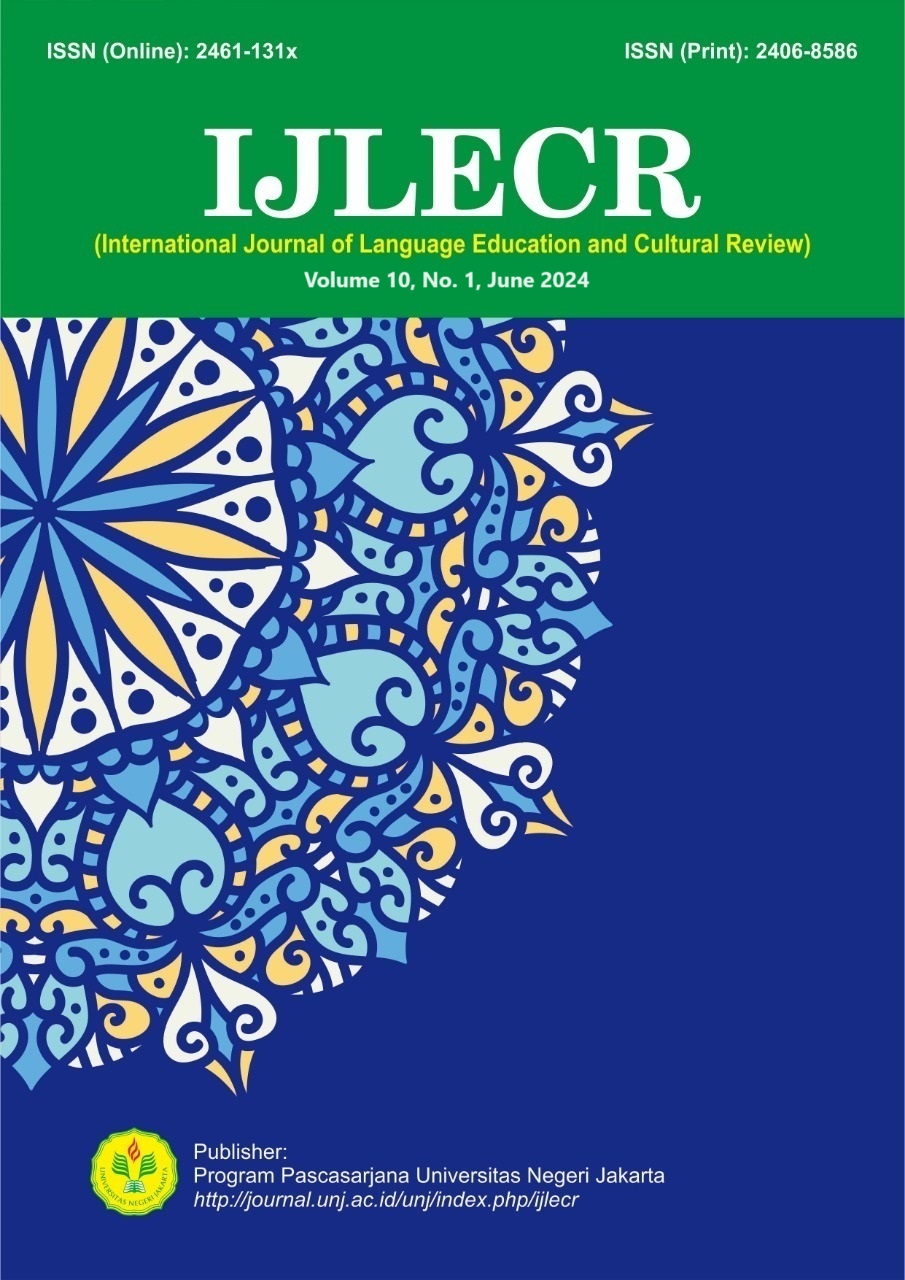The Distribution of Junior High School Students’ Language Awareness Across English Oral Proficiency and Oral Corrective Feedback Preference
DOI:
https://doi.org/10.21009/ijlecr.v10i1.45337Keywords:
English Oral Proficiency, Language Awareness, Oral Corrective FeedbackAbstract
Language awareness is crucial in langage learning. It entails how language is perceived and used by the students. Language awareness cannot be separated from teaching learning process since there are many interactions between teacher and students in the class including performing oral competency, learning from mistake, giving and taking oral corrective feedback. Thus, it stil uncovered yet that language awareness is really matter in junior high school. This research tried to investigate the level of language awareness of junior high school students across their oral proficiency level. The study also aims to find out whether students' level of language awareness is significantly different or not in their English oral language proficiency. In addition, the study also arried out to find out students type preference in receiving oral corrective feedback based on their language awareness level. This research is quantitative in nature. The data was collected from teacher archive in the form of students score and questionnaire. Then, the data was analyzed with the help of SPSS 20. The result showed that from 92 junior high school participant 35% of participants are in low level of language awareness; 32% in moderate level and 31% in high level. Based on the result, it can be concluded that majority of junior high school student are in low level of language awareness followed by moderate, and high. The analysis also showed that it retains the hypothesis of students’ language awareness level is similar across different English oral proficiency. Student with low, moderate, and high proficiency shows relatively similar level of language awareness level. Thus, the majority of students prefer explicit correction for oral corrective feedback type.
References
Audriyan, & Putri, H. P. (2021). Students language awareness in English classroom of English Education Study Program. Journal of English Language and Education (Jele), 6850(2), 237–250.
Awalin, A. S., Anam, S., & Purwanti, O. (2021). Student’s mistakes awareness in process of negotiation of meaning based on student’s level proficiency level. Linguistic, English Education and Art (LEEA) Journal, 4(2), 285–292. https://doi.org/10.31539/leea.v4i2.1353
Ba, E., & Lu, H. İ. Z. O. Ğ. (2020). Language Awareness and second language acquisition : is there a link ? Dil bilinci ve i kincil dil edinimi ba ğ lantisi metalinguistic awareness language awareness. 9, 721–732. https://doi.org/10.14686/buefad.764394
Bourke, J. M. (2008). A rough guide to language awareness. English Teaching Forum, 46(1), 12–21.
Cohen, L., Manion, L., & Morrison, K. (2017). Research methods in education. In Research Methods in Education. https://doi.org/10.4324/9781315456539
Dooly, M. (2017). “I h8 txt msgs”. How social media has had an impact on language awareness. In The Routledge Handbook of Language Awareness. https://doi.org/10.4324/9781315676494-19
Gholami, L. (2021). Oral corrective feedback and learner uptake in L2 classrooms: Non-formulaic vs. formulaic errors. Language Teaching Research. https://doi.org/10.1177/13621688211021560
Gustiani, T & Irwandi. (2024). Teacher and students’ awareness of language use. English Journal Literacy Utama, 8(1), 73-80, https://doi.org/10.33197/ejlutama.vol8.iss1.2023.5.455
Hamed Mahvelati, E. (2021). Learners’ perceptions and performance under peer versus teacher corrective feedback conditions. Studies in Educational Evaluation, 70(January), 100995. https://doi.org/10.1016/j.stueduc.2021.100995
Huda, F. (2020). Students’ Awareness of language use and language knowledge on efl learners. Journal of English Education, 5(2), 95–103. https://doi.org/10.31327/jee.v5i2.1284
Kennedy, S., & Trofimovich, P. (2010). Language awareness and second language pronunciation: A classroom study. Language Awareness, 19(3), 171–185. https://doi.org/10.1080/09658416.2010.486439
Laeli, A. F., & Setiawan, S. (2019). Oral corrective feedback in speaking class: Its frequency, students’ perceptions and preference. Exposure : Jurnal Pendidikan Bahasa Inggris, 8(2), 257–269. https://doi.org/10.26618/exposure.v8i2.2785
Lyster, R., Saito, K., & Sato, M. (2013). Oral corrective feedback in second language classrooms. Language Teaching, 46(1), 1–40. https://doi.org/10.1017/S0261444812000365
Munfadlila, W., Puspitasari, A., & Febrijanto, Y. (2019). The Students’ responses to teacher’s corrective feedback in English as a foreign language writing: A Case for nursing the students at STIKES Baptist Hospital Kediri. Appolo Project, 4(2), 144–158.
Pallant, J. (2020). Survival manual a step by step guide to data analysis using ibm spss 7th (7th ed.). London: Routledge.
Piper, D. (2003). Language awareness in nova scotia schools: an exploratory study. Brock Education Journal, 13(1), 61–71. https://doi.org/10.26522/brocked.v13i1.44
Putjata, G. (2018). Multilingualism for life–language awareness as key element in educational training: Insights from an intervention study in Germany. Language Awareness, 27(3), 259–276. https://doi.org/10.1080/09658416.2018.1492583
Rahmi, M. M., & Erlinda, R. (2014). Developing students’ language Awareness through discovery learning in English language teaching. 313–318.
Rassaei, E. (2015). Journal writing as a means of enhancing EFL learners’ awareness and effectiveness of recasts. Linguistics and Education, 32, 118–130. https://doi.org/10.1016/j.linged.2015.10.002
Roothooft, H., & Breeze, R. (2016). A comparison of EFL teachers’ and students’ attitudes to oral corrective feedback. Language Awareness, 25(4), 318–335. https://doi.org/10.1080/09658416.2016.1235580
Roy Lyster, & Leila Ranta. (1997). Corrective feedback and learner uptake: Negotiation of form in communicative classrooms. Studies in Second Language Acquisition, 19(01), 37–66. http://journals.cambridge.org/abstract_S0272263197001034
Sang, Y. (2017). A Conceptual review of Age effect on l2 acquisition. Journal of Education and Practice , 8(9), 1–4. https://files.eric.ed.gov/fulltext/EJ1139050.pdf
Svalberg, Agneta M.L. (2012). Language awareness in language learning and teaching: A research agenda. Language Teaching, 45(3), 376–388. https://doi.org/10.1017/S0261444812000079
Svalberg, Agneta Marie Louise. (2009). Engagement with language: Interrogating a construct. Language Awareness, 18(3–4), 242–258. https://doi.org/10.1080/09658410903197264
Van Ha, X., Murray, J. C., & Mehdi Riazi, A. (2021). High school efl students’ beliefs about oral corrective feedback: The role of gender, motivation and extraversion. Studies in Second Language Learning and Teaching, 11(2), 235–264. https://doi.org/10.14746/ssllt.2021.11.2.4
Vuono, A., & Li, S. (2021). Age and corrective feedback. The Cambridge Handbook of Corrective Feedback in Second Language Learning and Teaching, May, 645–667. https://doi.org/10.1017/9781108589789.031
Zare, M., Shooshtari, Z. G., & Jalilifar, A. (2022). The interplay of oral corrective feedback and L2 willingness to communicate across proficiency levels. Language Teaching Research, 26(6), 1158–1178. https://doi.org/10.1177/1362168820928967








